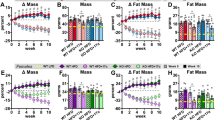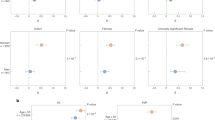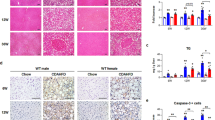Abstract
Background:
Treatment with estrogen in early menopausal women protects against development of hepatic steatosis and nonalcoholic fatty liver disease but estrogen has undesirable side effects, which negate its beneficial effects in premenopausal and postmenopausal women. Targeted therapies require better understanding of the target sites and mechanisms by which estrogen signaling exerts its protective effects in women. Estrogen receptor α (ERα) is thought to be the primary mediator for estrogen signaling to protect against hepatic steatosis. ERα has several mechanisms for signal transduction: (1) inducing gene transcription by direct binding to specific DNA sequences, (2) inducing tethered transcription with other DNA-binding factors, and (3) stimulating nongenomic action through membrane-associated ERα. However, it is still unclear which mechanisms mediate ERα-dependent protection against hepatic steatosis.
Methods:
To understand the mechanisms of estrogen signaling for protection against hepatic steatosis in females, we analyzed the global ERα knockout mouse (αERKO), ERα DNA-binding domain mutant mouse (KIKO) and liver-specific ERα knockout mouse (LERKO) fed high-fat diets (HFD). The KIKO mouse disrupts the direct DNA-binding transcription activity but retains tethered transcription regulation and nongenomic action. Hepatic steatosis was evaluated by scoring the macrovesicular and microvesicular steatosis as well as serum alanine aminotransferase (ALT) levels. We analyzed serum testosterone to assess its correlation with hepatic steatosis.
Results:
Liver fat accumulation was far greater in HFD-fed αERKO and KIKO females than in HFD-fed wild-type (WT) controls. Conversely, HFD-fed LERKO females did not accumulate excess liver fat. HFD-fed αERKO and KIKO females showed higher microvesicular steatosis and ALT levels than WT controls that correlated with increased serum testosterone levels.
Conclusions:
ERα-mediated direct transcription in non-hepatic tissues is essential for estrogen-mediated protection against hepatic steatosis in HFD-fed females. The balance between non-hepatic estrogen signaling and hepatic or non-hepatic testosterone action may control hepatic steatosis.
This is a preview of subscription content, access via your institution
Access options
Subscribe to this journal
Receive 12 print issues and online access
$259.00 per year
only $21.58 per issue
Buy this article
- Purchase on Springer Link
- Instant access to full article PDF
Prices may be subject to local taxes which are calculated during checkout






Similar content being viewed by others
References
Tiniakos DG, Vos MB, Brunt EM . Nonalcoholic fatty liver disease: pathology and pathogenesis. Annu Rev Pathol 2010; 5: 145–171.
Ford ES, Kohl HW, Mokdad AH, Ajani UA . Sedentary behavior, physical activity, and the metabolic syndrome among U.S. adults. Obes Res 2005; 13: 608–614.
Ambrosini GL, Huang RC, Mori TA, Hands BP, O'Sullivan TA, de Klerk NH et al. Dietary patterns and markers for the metabolic syndrome in Australian adolescents. Nutr Metab Cardiovasc Dis 2010; 20: 274–283.
Koulouri O, Ostberg J, Conway GS . Liver dysfunction in Turner's syndrome: prevalence, natural history and effect of exogenous oestrogen. Clin Endocrinol (Oxf) 2008; 69: 306–310.
Saphner T, Triest Robertson S, Li H, Holzman P . The association of nonalcoholic steatohepatitis and tamoxifen in patients with breast cancer. Cancer 2009; 115: 3189–3195.
Flegal KM, Carroll MD, Ogden CL, Johnson CL . Prevalence and trends in obesity among US adults, 1999-2000. JAMA 2002; 288: 1723–1727.
Munoz J, Derstine A, Gower BA . Fat distribution and insulin sensitivity in postmenopausal women: influence of hormone replacement. Obes Res 2002; 10: 424–431.
Beral V, Bull D, Reeves G Million Women Study Collaborators. Endometrial cancer and hormone-replacement therapy in the Million Women Study. Lancet 2005; 365: 1543–1551.
D'Eon TM, Souza SC, Aronovitz M, Obin MS, Fried SK, Greenberg AS . Estrogen regulation of adiposity and fuel partitioning. Evidence of genomic and non-genomic regulation of lipogenic and oxidative pathways. J Biol Chem 2005; 280: 35983–35991.
Hewitt KN, Pratis K, Jones MEE, Simpson ER . Estrogen replacement reverses the hepatic steatosis phenotype in the male aromatase knockout mouse. Endocrinology 2004; 145: 1842–1848.
Chow JDY, Jones MEE, Prelle K, Simpson ER, Boon WC . A selective estrogen receptor α agonist ameliorates hepatic steatosis in the male aromatase knockout mouse. J Endocrinol 2011; 210: 323–334.
Maffei L, Murata Y, Rochira V, Tubert G, Aranda C, Vazquez M et al. Dysmetabolic syndrome in a man with a novel mutation of the aromatase gene: effects of testosterone, alendronate, and estradiol treatment. J Clin Endocrinol Metab 2004; 89: 61–70.
Smith EP, Boyd J, Frank GR, Takahashi H, Cohen RM, Specker B et al. Estrogen resistance caused by a mutation in the estrogen-receptor gene in a man. N Engl J Med 1994; 331: 1056–1061.
Heine PA, Taylor JA, Iwamoto GA, Lubahn DB, Cooke PS . Increased adipose tissue in male and female estrogen receptor-alpha knockout mice. Proc Natl Acad Sci USA 2000; 97: 12729–12734.
Bryzgalova G, Gao H, Ahren B, Zierath JR, Galuska D, Steiler TL et al. Evidence that oestrogen receptor-alpha plays an important role in the regulation of glucose homeostasis in mice: insulin sensitivity in the liver. Diabetologia 2006; 49: 588–597.
Arao Y, Coons LA, Zuercher WJ, Korach KS . Transactivation function-2 of estrogen receptor α contains transactivation function-1-regulating element. J Biol Chem 2015; 290: 17611–17627.
Jakacka M, Ito M, Weiss J, Chien PY, Gehm BD, Jameson JL . Estrogen receptor binding to DNA is not required for its activity through the nonclassical AP1 pathway. J Biol Chem 2001; 276: 13615–13621.
Acconcia F, Ascenzi P, Bocedi A, Spisni E, Tomasi V, Trentalance A et al. Palmitoylation-dependent estrogen receptor alpha membrane localization: regulation by 17beta-estradiol. Mol Biol Cell 2005; 16: 231–237.
Jakacka M, Ito M, Martinson F, Ishikawa T, Lee E-J, Jameson JL . An estrogen receptor (ER) alpha deoxyribonucleic acid-binding domain knock-in mutation provides evidence for nonclassical ER pathway signaling in vivo. Mol Endocrinol 2002; 16: 2188–2201.
Zhu L, Brown WC, Cai Q, Krust A, Chambon P, McGuinness OP et al. Estrogen treatment after ovariectomy protects against fatty liver and may improve pathway-selective insulin resistance. Diabetes 2013; 62: 424–434.
Matic M, Bryzgalova G, Gao H, Antonson P, Humire P, Omoto Y et al. Estrogen signalling and the metabolic syndrome: targeting the hepatic estrogen receptor alpha action. PLoS One 2013; 8: e57458.
Hewitt SC, Kissling GE, Fieselman KE, Jayes FL, Gerrish KE, Korach KS . Biological and biochemical consequences of global deletion of exon 3 from the ER gene. FASEB J 2010; 24: 4660–4667.
Yeh MM, Brunt EM . Pathology of fatty liver: differential diagnosis of non-alcoholic fatty liver disease. Diagn Histopathol 2008; 14: 586–597.
Farese RV, Zechner R, Newgard CB, Walther TC . The problem of establishing relationships between hepatic steatosis and hepatic insulin resistance. Cell Metab 2012; 15: 570–573.
Tsochatzis E, Papatheodoridis GV, Archimandritis AJ . The evolving role of leptin and adiponectin in chronic liver diseases. Am J Gastroenterol 2006; 101: 2629–2640.
Page ST, Herbst KL, Amory JK, Coviello AD, Anawalt BD, Matsumoto AM et al. Testosterone administration suppresses adiponectin levels in men. J Androl 2005; 26: 85–92.
Park CJ, Zhao Z, Glidewell-Kenney C, Lazic M, Chambon P, Krust A et al. Genetic rescue of nonclassical ERα signaling normalizes energy balance in obese Erα-null mutant mice. J Clin Invest 2011; 121: 604–612.
Liu S, Le May C, Wong WPS, Ward RD, Clegg DJ, Marcelli M et al. Importance of extranuclear estrogen receptor-alpha and membrane G protein-coupled estrogen receptor in pancreatic islet survival. Diabetes 2009; 58: 2292–2302.
Hewitt SC, Li L, Grimm SA, Winuthayanon W, Hamilton KJ, Pockette B et al. Novel DNA motif binding activity observed in vivo with an estrogen receptor α mutant mouse. Mol Endocrinol 2014; 28: 899–911.
Ahlbory-Dieker DL, Stride BD, Leder G, Schkoldow J, Trölenberg S, Seidel H et al. DNA binding by estrogen receptor-α is essential for the transcriptional response to estrogen in the liver and the uterus. Mol Endocrinol 2011; 23: 1544–1555.
Behari J, Li H, Liu S, Stefanovic-Racic M, Alonso L, O'Donnell CP et al. β-catenin links hepatic metabolic zonation with lipid metabolism and diet-induced obesity in mice. Am J Pathol 2014; 184: 3284–3298.
Acknowledgements
We thank David Monroy and NIEHS Comparative Medicine Branch staff for animal care; Huaxia Cui and Michael Meuhlbauer (Duke Molecular Physiology Institute) for hormone assays; the staff of the NIEHS Histology Core for histology; and the staff of NIEHS Molecular Genomics Core Laboratory for microarray analysis. This study was funded by grants from the Division of Intramural Research of the NIEHS/NIH (to KSK, 1ZIAES70065), the NIDDK/NIH (to SHU, F32DK93200) and the American Diabetes Association (to MF, 7-13-BS-050).
Author contributions
SHU, DEM, KJH and SLL conceived and carried out the experiments. YA, SCH, MF and KSK conceived the experiments and analyzed data. All authors were involved in writing the paper and had final approval of the submitted version.
Author information
Authors and Affiliations
Corresponding author
Ethics declarations
Competing interests
The authors declare no conflict of interest.
Additional information
Supplementary Information accompanies this paper on International Journal of Obesity website
Supplementary information
Rights and permissions
About this article
Cite this article
Hart-Unger, S., Arao, Y., Hamilton, K. et al. Hormone signaling and fatty liver in females: analysis of estrogen receptor α mutant mice. Int J Obes 41, 945–954 (2017). https://doi.org/10.1038/ijo.2017.50
Received:
Revised:
Accepted:
Published:
Issue Date:
DOI: https://doi.org/10.1038/ijo.2017.50
This article is cited by
-
Diabetes mellitus in breast cancer survivors: metabolic effects of endocrine therapy
Nature Reviews Endocrinology (2024)
-
Estrogen receptor activation remodels TEAD1 gene expression to alleviate hepatic steatosis
Molecular Systems Biology (2024)
-
Abrogation of greater graft failure risk of female-to-male liver transplantation with donors older than 40 years or graft macrosteatosis greater than 5%
Scientific Reports (2023)
-
Fatty Liver Index and Development of Cardiovascular Disease: Findings from the UK Biobank
Digestive Diseases and Sciences (2021)
-
Increased liver echogenicity and liver enzymes are associated with extreme obesity, adolescent age and male gender: analysis from the German/Austrian/Swiss obesity registry APV
BMC Pediatrics (2019)



